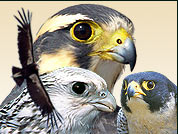|
The status codes used in GRIN are based largely on the
categories proposed by the IUCN (1986) and adopted by BirdLife
International in their Threatened birds of the world
(2000), where fuller details are provided on the criteria used
to define them. The categories are as follows:
Extinct: It is known for certain that the last
individual died.
Extinct in wild: Species surviving only in captivity.
Critically endangered: Species facing imminent
extinction. Species placed in this category here may be
represented by less than 10 living individuals.
Endangered: Species facing a high risk of extinction
in the near future without human intervention.
Vulnerable: Species facing a high risk of extinction
the mid-term future, given present trends in population declines
and threats. This term is generally equivalent to "threatened,"
a category used in many other classifications.
Near Threatened: Species not in trouble at the moment, but which require some level of management to maintain healthy populations. Equivalent to "Conservation Dependent" in other classifications..
Lower risk: Species which are not at risk at the
species level, although they may include subpopulations that are
experiencing problems at regional or local levels.
Data deficient: Species for which too few data are
available to adequately assess their status. Following further
study, many of these may prove to be Conservation Dependent
or Vulnerable.
|

